I'm a PhD candidate at Stanford University and I use this Tumblr blog to share my thoughts on various topics in politics, economics, and finance.
Don't wanna be here? Send us removal request.
Text
College Football & Econometrics --> Fun with Matching
My friend Stephen Pettigrew, a PhD candidate in the Department of Government at Harvard, and I recently published a post on Deadspin's Regressing blog.
The question we ask is how different college football teams have performed when featured in the national spotlight of ESPN's College Gameday. To do so, we compare their outcomes in such games to otherwise comparable games. In other words, we ask do any of the teams regularly featured on Gameday suffer from a "Gameday curse" and do some of them even potentially benefit from a "Gameday bump"?
To answer this question, we use the statistical method of matching on observables. The results we derive are displayed in the graph below and the full writeup is available here.
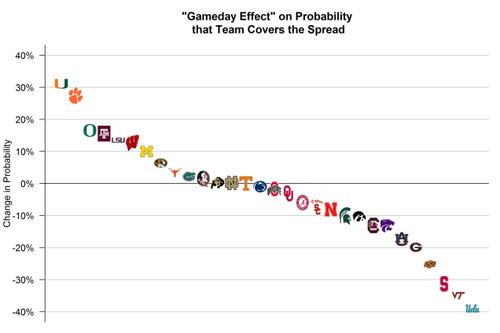
3 notes
·
View notes
Text
Ending Gerrymandering
The unpopular yet seemingly pervasive practice of gerrymandering may have may its match: programmer Brian Olson. Using the 2010 census data, Olson developed a program to automate the process of redrawing legislative districts (on both the state and federal level). He improves on previous efforts by not simply drawing lines that minimize district size, but by making districts as compact as possible without putting one neighborhood (i.e. census tract)* in more than one district.
Here's an example of the result:
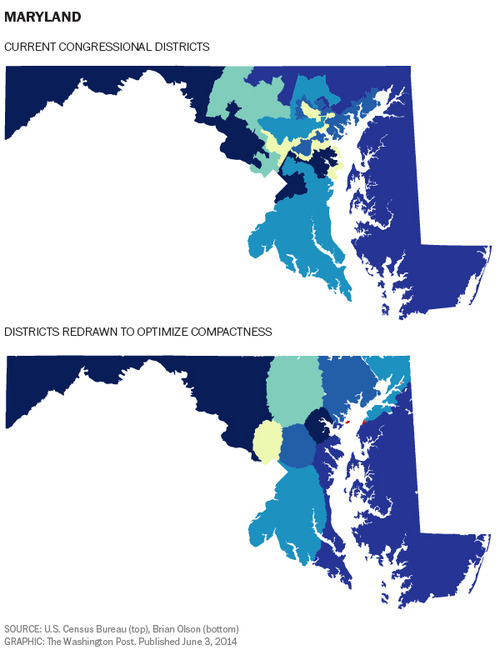
While this is an exciting development and I think state legislators would be wise to implement a version of Brian's work, we (probably) shouldn't view this as a panacea. As John Sides has argued, "gerrymandering is not what’s wrong with American politics."
*According to the Census Bureau, "census tracts generally have a population size between 1,200 and 8,000 people, with an optimum size of 4,000 people. A census tract usually covers a contiguous area; however, the spatial size of census tracts varies widely depending on the density of settlement."
1 note
·
View note
Photo
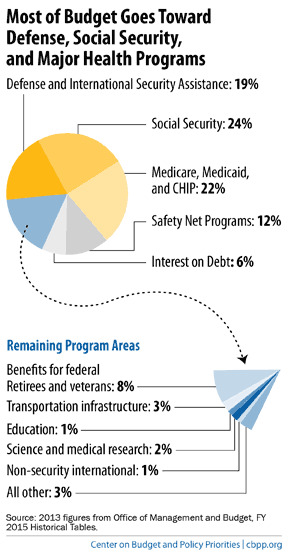
Looking at where our taxes go on tax day
1 note
·
View note
Photo
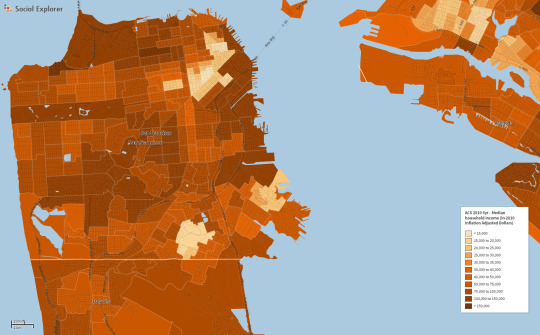
A view at the spatial distribution of income in San Francisco.
Produced via Social Explorer. Data source: ACS 2010 5yr - Median household income in 2010 Inflation Adjusted Dollars.
2 notes
·
View notes
Text
What Can Finance Tell Us About Auburn's Road to Pasadena?
There's no way around it: Auburn's journey to tonight's game was unbelievable. Even the most optimistic Tiger fans weren't expecting to make it to Pasadena this year. But here we are, only a few hours away from Gus Malzahn leading his team into the Rose Bowl with the National Title on the line.
Given the crazy series of events that lead to today, the question I've been asking myself is when did people finally start realizing that Auburn was this year's team of destiny? The "Prayer at Jordan-Hare" was about as miraculous as any fourth quarter heave in recent college football history, but that merely kept the hope of Pasadena alive and set up the biggest Iron Bowl ever. Of course, we all know how that transpired, but, again, even after "Kick Bama Kick," Auburn still needed to take down a tough Mizzou team in the Georgia Dome and pray for a Michigan State upset of Ohio State in the B1G Championship game.
On December 7, the stars aligned yet again for the Tigers and both remaining pieces of the puzzle went Auburn's way, setting up today's matchup with Florida State.
So let's return to my question: which piece of the puzzle was the one that convinced the world that Auburn would be here today? One way to answer this would be to examine bets coming into Vegas on whether Auburn would make it to Pasadena and see where the surge is. Unfortunately, I'm not a bookie and thus don't have access to such data (if you are and would like to share, please let me know!). However, there is an alternative data source that can offer basically the same insights.
TeamTix is a company that offers fans the right to reserve face-value tickets to bowl games (among other sporting events) if their team makes it to that game. Those in finance refer to this as a forward market: you pay today for the delivery of an asset tomorrow. In this case, that asset is just a reservation to buy tickets to see your team play in the big game. Of course, that asset may be worth a lot if the team makes it to the game, but would be worthless if they don’t (making this also similar to a call option).
The price for making these reservations is driven by supply and demand and the mechanics of this forward market are pretty straightforward. Just like you do when trading stocks, you place a bid when you think a team is undervalued (more likely to make the bowl game than their current price reflects) and offer to sell a reservation you hold when you think the team is overvalued (not as likely to make it). The phenomenon produced by everyone doing this at once is that TeamTix prices reflect the "market's" interpretation of the probabilities of teams making it to the big game. In other words, schools that are seen as very likely to make it, like Alabama prior to the Iron Bowl, have high prices, while schools that aren't seen as darkhorse candidates have much lower prices. And these prices are fluctuating 24/7. Best of all, TeamTix sends a tweet every time a new purchase is made in their BCS Championship ticket marketplace.
So what are the moments that matter? There are two that induced by far the most movement in the market (see chart below).
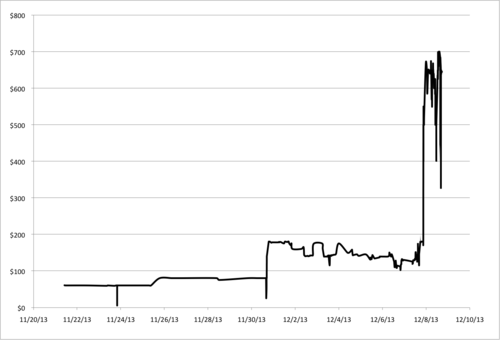
First, on the day of the Tigers upset of Alabama, there were steady purchases of Auburn reservations on the forward market, with prices hovering around $80. Just literally one minute after Chris Davis ran 109 yards (i.e. 7:26 pm EST), purchases for Auburn tickets came flying in. 16 new orders were made within 10 minutes, pushing prices up to $140 and going up to $180 by 10 pm that night.
From here, things were pretty calm on the Auburn ticket market, with prices actually falling over the next week (they hit of low of $102 on Friday night). Presumably, this can be attributed to Auburn fans (and speculators) realizing that an appearance in the title game hinged on Urban Meyer’s Buckeyes losing to Michigan State, an outcome many saw as unlikely.
On the day of the SEC Championship, the forward market for Auburn tickets saw a steady slew of orders, but prices remained fairly stable, climbing only to $5 to $133 before kickoff. They stayed here for much of the game and didn’t really start rising substantially until the game was called at 8:06 pm EST. Over sixty orders came in over that hour and prices rose up to $180. Of course, though the real action was still to come, as the OSU-MSU game wouldn’t finish for a few more hours.
After Connor Cook’s 9-yard touchdown pass to Josiah Price gave MSU a 27-24 lead with 11:41 to go in the fourth quarter, action started again in the TeamTix marketplace. Still, prices didn’t change much until 8:40 PM, when the Spartan D stopped Braxton Miller on 4th-and-2. By the time Jeremy Langford ran in the game-sealing 26-yard touchdown, the price to reserve tickets to see Auburn play for the BCS title had soared to $480. Between the conclusion of the game just before midnight and the BCS’ announcement that Auburn had officially made it to Pasadena, 137 orders came in, with prices peaking at $700 that afternoon.
The fat lady had sung and now fans were finally ready to put down their money on the upstart Auburn Tigers. We’ll find out tonight if that was money well spent.
0 notes
Text
On the perils of extrapolationlocal regression
The Bureau of Labor Statistics released the jobs' numbers for the month of November and many were pleased to see the unemployment rate fall from 7.3% to 7.0%. This was seen by many as positive news and the stock market jumped as a result.
However, not everyone viewed the news through rose colored glasses.
The chart that will make you worry about the labor market. pic.twitter.com/S25cSyEwhx
— Justin Wolfers (@JustinWolfers) December 6, 2013
He makes an important point: we shouldn't consider the jump from October to November that meaningful given that the labor market was highly distorted by the government shutdown that lasted the first two weeks of that month. By showing that employment actually dipped from September to November (according to "the household adjustment survey data adjusted to a payroll concept"), he implies that we should be actually quite worried about the labor market.
After seeing this tweet, I set out to see if a longer pattern in the data match corroborate his conclusion. To do this, I downloaded the past 5 years of civilian employment data* from the FRED database and fit two loess (aka local regression) curves. The first (in blue) has a span* of 1/5, while the second (in dark green) had a span of 2/5. Otherwise, the two are identical.

This subtle difference turns out to be pretty important in evaluating the November jobs report. By fitting the blue loess curve to the previous 60 months of data (September 2009 - September 2013), we predict employment of 144,127,300. Our predict using the red loess curve is 144,592,200, a difference of 464,900 jobs. Perhaps more importantly, the blue curve says the labor market is out performing our expectations, while the red curve says the opposite. This important difference can be solely attributed to seems like an unimportant or minor modeling choice. This is an lesson for all of us working in data science to remember when interpreting data.
*This data set is close but not identical to the one Wolfers uses. I was unable to find the exact data set that he did.
**The span is also known as the smoothing parameter and is represented by alpha in regression equations. A larger alpha corresponds to fewer local regressions being run, while a smaller alpha uses fewer data points to construct the smoothing curve. When alpha is equal to one (the upper bound) the loess is identical to a standard linear regression.
0 notes
Text
Who do you think will win the Nobel Prize in Economics?
On Monday, the Nobel committee will announce who will be awarded their Prize in Economic Sciences. The winner will get a medal, a personal diploma, and a cash prize (8 million Swedish Krona or ~$1.2 million).

Fun fact: Franco Modigliani used some of his $225,000 Nobel Prize money to upgrade his laser-class sailboat.
So who are the front-runners? According to British betting house Paddy Power, the favorite (at 4/1 odds) is Yale housing and financial economist Robert Schiller. Tied for second at 5/1 are Harvard macroeconomist Robert Barro, LSE econometrician Anthony Atkinson, and NYU development economist Paul Romer. Here's the full set of odds:

While whoever wins this award will no doubt have a career defining moment when they receive the phone call, it doesn't actually mean their reputation in the field will change that much. According to research by Samuel Bjork, Avner Offer, and Gabriel Söderberg in Scientometrics, winning the Nobel provides a small boost to citations in the short-run, but then citations begin to decline. As The Economist explains, "people tend to win Nobel prizes when their career has nearly reached its peak. The Swedish Academy, which makes the award, plays it safe."

Anyways, I'm looking forward to finding out who wins!
0 notes
Text
Is there an end in sight? My $0.02 on the shutdown
Every since the shutdown began at midnight on Monday, pundits of every shape, size, and color have pointed out that there's a silver bullet: allowing a vote on a clean continuing resolution (CR) would refund the government and "everything would return to normal." After all, there have been 20 relatively moderate Republicans (listed here) who have publicly supported the passage of a clean CR. Combine these votes with 200 from the members of the House Democratic caucus and the numbers are looking really good for those, like me, supporting the end of the shutdown.
However, just because a clean CR would pass if it got to the floor does not mean it will get there. That's because Speaker Boehner has invoked the Hastert Rule, thereby giving him the sole power to decide what gets on the agenda and he has every incentive to hold onto that, preventing a vote that he won't support. Still, there is a way around Boehner's control of the floor: the discharge petition. News that Pelosi and the House Democrats are seeking to use this instrument threw the Twittersphere into a tizzy on Friday.
House Dems may have found a way to use a discharge petition to bring a clean CR to a vote: http://t.co/yYe8CtW9w8
— Ezra Klein (@ezraklein)
October 4, 2013
Dems plan discharge petition to force vote on ending shutdown http://t.co/nwtllfDK9x
— The Hill (@thehill)
October 4, 2013
While this is a promising (if unsurprising) development, it doesn't mean that government employees should get ready to return to work. This is true for two reasons.
The first is that the discharge petition is designed to be slow. And I mean really slow. GW political scientist Sarah Binder explains:
Time lags built into the discharge rule are bound to frustrate lawmakers if they seek to open a shuttered government. Even if an aspiring lawmaker bones up on the House rule book and today introduces a CR and a discharge motion to dislodge it, the earliest the motion to discharge would make its way onto the discharge calendar after securing 218 signatures would be November. (I am assuming that the House’s calendar and legislative days run roughly in tandem this month). If the motion doesn’t make it onto the calendar until after the second Monday of the month, the bill would be discharged at the earliest in late November. Procedural details make the discharge rule ill-suited for swift enactment of a clean CR.
The second reason is that it's costly for centrist Republicans to add their names to the petition (for more on this, read Molly Jackman's blog post and Brookings white paper). The point here is simple: a moderate Republican signing onto the discharge petition would, to put it bluntly, really piss off Boehner. So the next time that legislator was trying to get her pet bill or amendment passed, she may not find a supportive audience in the Speaker's office. Thus, these legislators have to decide which is more important for them: pleasing their centrist constituents who want the shutdown to end or maintaining a positive working relationship with the party leadership, a necessary component for future legislative success.
If these middle-of-the-road Republicans had a really short time horizon and were facing a general election opponent tomorrow, they'd probably side with Pelosi and the shutdown would end. Of course, we're still pretty far away from that (and for many, the more pressing electoral concern is fending off primary challengers) so these officials aren't all likely going to blow their political capital on ending the shutdown.
That leads to a final question: what would have to change for the discharge petition to succeed? Another way of putting this is at point does continuing the shutdown becoming costlier for the "swing legislators" (the moderate Republicans) than defecting from Speaker Boehner (assuming his stance doesn't evolve). This decision-making calculus is illustrated in the figure below.

The red curve illustrates the costs of continuing the shutdown. While many individuals in these key districts are already severely adversely affected, what really matters is the pain that the median voter there is facing. Surely, the "average" person in, say, Republican Congressman Devin Nunes' 22nd district of California is annoyed with this state of affairs, but probably isn't overwhelmingly personally affected. However, as the shutdown continues, they're likely to face some increasing inconvenience (e.g. canceling their annual backpacking trip to Yosemite) or direct cost (they can't purchase federal crop insurance). Thus, the costs begin to rise exponentially, though they are bounded at some upper level.
At the same time, the costs to the moderate Republicans of signing onto the discharge petition drops considerably over time (the blue curve). There are two reasons for this. First, it is easier to defect as the shutdown becomes even more unpopular and Speaker Boehner's power in the halls of Congress wanes. Second, as more fellow Republicans defect, it is easier for you to defect. Think of this as a tipping point: being the first Republican to sign onto Pelosi's discharge petition is pretty risky since you don't always know if others will follow (you probably don't want to be the first to stick your neck out), but being the 18th is much less so. After all, there are strength in numbers when making a politically risky move.
Ultimately, at some point, t*, in the figure, the blue and red curves intersect and that is when the shutdown will end. It will be simply too costly for the swing legislators to not sign onto the discharge petition at that point. Let's hope that we reach that point sooner rather than later.
1 note
·
View note
Text
via wheninwashington:
When the government shutdown hits day four
4 notes
·
View notes
Photo

“The first duty of a man is to think for himself.”
José Martí
23 notes
·
View notes
Text
Detroit's Bankruptcy: A Political Decision?
Detroit is bankrupt. The city filed its ch. 9 paperwork on Thursday afternoon after Kevyn D. Orr, the city's emergency manager, and Governor Rick Snyder deemed that to be the only "viable option" left. This is a fascinating situation, given its magnitude (this is the largest municipal bankruptcy ever) and political implications (who is Orr really answering to?). Stay tuned.
UPDATE:
woah RT @igorbobic Detroit's back! RT @lindarothcnn BREAKING Judge orders Detroit to withdraw bankruptcy filing; says it is unconstitutional
— Lucas Puente (@lucaspuente) July 19, 2013
0 notes
Photo
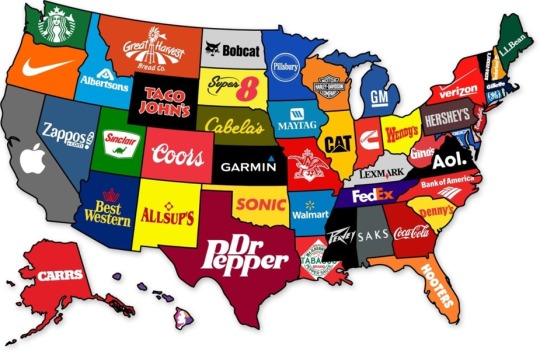
Cool graphic showing the most prominent company from each of the 50 states. Thanks to graphic designer Steve Lovelace for creating it. Read the rationale behind his choices at http://bit.ly/14u6Zl3.
5 notes
·
View notes
Photo
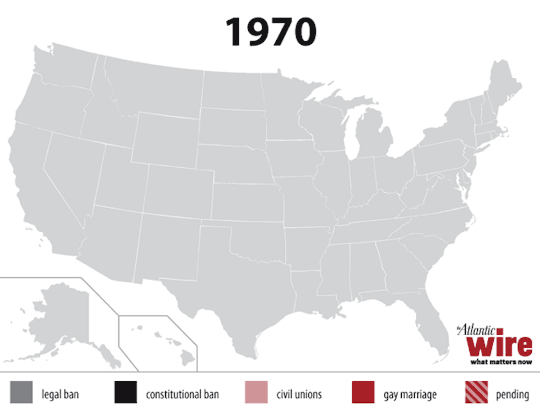
17K notes
·
View notes
Text
Big news in the past 24 hours
You've probably already heard about all of this, but it's still worth discussing. The news cycle has been pretty momentous for social issues over the last 24 hours. Here's a quick recap:
1. Wendy Davis spent 13 hours yesterday successfully filibustering an anti-abortion bill in the Texas State Senate that would have closed almost all of the clinics in the state that offer abortions. This isn't the first time Davis has fought her Republican counterparts. In 2011, she forced Gov. Perry to call a special session to pass the budget after her 76-minute filibuster protesting cuts to spending on public education. Davis also has an inspiring story, going from a single teenage mom to a graduate of Harvard Law (see video below). She could now be primed for state-wide or national office soon. After all, state Democratic Chairman Gilberto Hinojosa called her "one of our top superstars in Texas."
2. The Supreme Court struck down section 3 of the Defense of Marriage Act. This means that homosexual married couples are subject to equal protection under the law. This means that the federal government will now recognize same-sex marriages celebrated in states in which it is legal. As of today, this includes 12 states (Massachusetts, Connecticut, Iowa, Vermont, New Hampshire, New York, Maine, Washington, Delaware, Maryland, Rhode Island, Minnesota) as well as DC and 5 tribal areas. We'll also soon be able to add California to that last list (more on this below), which brings me to my next point...
3. The SCOTUS issued a narrow ruling in the Prop 8 case (Hollingsworth et al. v. Perry et al.). Writing for the 5-justice majority, Chief Justice Roberts declared that the the defenders of my state's ban on same-sex marriages did not have standing in court. That is, since neither Gov. Brown nor Attorney General Kamala Harris refused to defend the measure, no one could. Bob Egelko of the San Francisco Chronicle describes the implication of the ruling:
By finding that the sponsors lacked standing to appeal the rulings, the high court reinstated an August 2010 decision by then-Chief U.S. District Judge Vaughn Walker of San Francisco that the California measure was an irrational act of discrimination based on sexual orientation and gender.
These two rulings were a bit surprising to me since the court's other decisions this week were of a more conservative bent, especially the invalidation of the key part of the Voting Rights Act. The court has also become much more conservative since Sandra Day O'Connor's retirement in 2005. According to the Martin-Quinn scores that track the ideology of the Supreme Court, the institution's current median justice, Anthony Kennedy, is more conservative (higher score) than any on record.
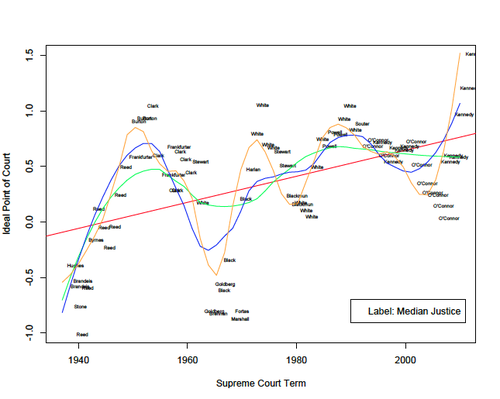
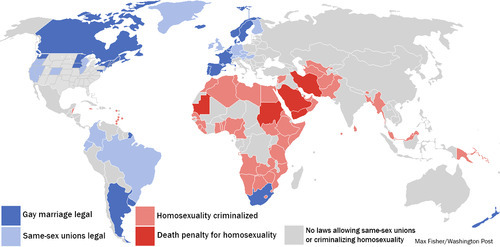
However, at least for now (and for once), the US is on the forefront of progress in the fight for marriage equality. This is especially true when comparing marriage policy in the states to that of our peers across the world. Gay marriage is only allowed in 14 other countries and homosexuality is actually criminalized in 76 others.
Despite this progress, it is important to remember that the fight for true equality isn't over. We're going to need more impassioned fighters, like Wendy Davis, to finally end LGBT discrimination in our country. As Macklemore and Ryan Lewis put it, "a certificate on paper isn't gonna solve it all, but it's a damn good place to start."
#social issues#marriage equality#prop8#scotus#american politics#supreme court#doma#defense of marriage act#john roberts#martin-quinn scores#ideal points
2 notes
·
View notes
Quote
The U.S. immigration system makes it easy for sports stars to work in America, but the system makes it hard for star scientists, would-be entrepreneurs and others to show their stuff here. Imagine if the current or proposed visa and immigration rules for determining who can come to the U.S. to work applied to athletes. First there would be a low cap on the number of foreign players allowed into the country each year, one well below what the market demands. The total number of foreign players might be limited to a dozen a year, across all sports, with no team allowed more than one. But first the players would be told wait years, even a decade, before joining their teams. Teams would have to prove that they advertised the position and tried to hire an American first, but couldn’t find one. This is essentially how the H1-B visa system for high-skill immigrants works. Oh, and there would be limits on how many players could come from any one country, and each country would be given the same number of slots in the name of fairness. Too bad for the NHL: That would mean 10 slots for hockey players from Canada, 10 from Tanzania and 10 from the Philippines. But at least everyone would get an equal chance. That’s how current caps on employment visas work, with no country allowed more than 7% of the total. It’s a system that treats China and Chad the same.
Fergus Cullen: Those ‘Guest Workers’ of the NBA and NHL - WSJ.com
0 notes
Text
Riding the publicity wave: the debate over the bike lobby continues
The bike lobby is a hot topic these days on the interwebs. Ever since Wall Street Journal editorial board member Dorothy Rabinowitz's rant against the "all powerful bike lobby" (see my original post here), people haven't stopped talking about the political activities of cyclists -- especially the WSJ.
Byron Tau and Caitlin Emma, reporters for Politico, posted an article on the subject yesterday and offered a realistic interpretation of the actual influence of said group:
All-powerful the bike lobby is not. Cars — and the infrastructure needed to accommodate them — receive an overwhelming percentage of federal, state and local transportation dollars. But a scrappy band of bicycle manufacturers, smart-growth advocates and cycling nonprofits is increasingly fighting — and winning — battles at all levels of government.
This trend will likely continue as such groups expand their collective action efforts and develop a lobbying / electoral apparatus. One sign that this is indeed happening: the NY Times reports that StreetsPAC, a coalition of "advocates for cycling and pedestrian safety," just offered its first formal endorsements of city council candidates. Out here, the San Francisco Bike Coalition flexed its muscles in the 2012 election for the Board of Supervisors and continues to engage local officials to make the city's roads more bike friendly.

Still, despite growing every day, it's hard to disagree with Politico's Tau and Emma: the bike lobby is, undeniably, far from all powerful. As it emerges from its infancy, though, that could change. Personally, I hope so. That would level the playing field a bit in the debate over the future of urban transportation policy.
#Bikes#cycling#transportation policy#other#bike lobby#bike lanes#city politics#nyc politics#ny politics#citibike#dorothy rabinowitz#bike coalition#sf bike coalition#streetspac
0 notes
Text
The politics of Silicon Valley
If you haven’t already read George Packer’s article in The New Yorker on the politics of the tech industry and its impact on SF, the Bay Area, and the beltway, you really should.
In general, he is somewhat critical of what he sees as the tech industry's overconfidence in its positive impact on the world as well as its self-serving approach to public policy. Here's one particularly compelling except in which Packer quotes Josh Cohen, one of the professors in my department at Stanford:
“There is this complete horseshit attitude, this ridiculous attitude out here, that if it’s new and different it must be really good, and there must be some new way of solving problems that avoids the old limitations, the roadblocks. And with a soupçon of ‘We’re smarter than everybody else.’ It’s total nonsense.”

Still, it is more descriptive than anything and Packer offers a well-rounded take on the industry's growing political engagement. His interviews with entrepreneurs, political scientists, and public officials are reveal a lot about these evolving relationships. One omission I wish he did address though: the degree to which these tech leaders are cultivating a healthy relationship with Nancy Pelosi, who, in addition to serving as the most powerful Democrat in the House, represents SF in Congress.
Anyways, it is a very well done article and definitely worth reading. Check it out for yourself here.
0 notes